 do its job” alt=”California’s cap-and-trade system may be too weak to do its job” />
do its job” alt=”California’s cap-and-trade system may be too weak to do its job” />
California’s cap-and-trade system may be too weak to do its job
It was designed to please Big Oil. That may be all it does.
By
David Roberts@drvox
Updated
Dec 13, 2018, 12:43pm EST
Share
Tweet
Share
Share
California’s cap-and-trade system may be too weak to do its job
tweet
share
California is regarded as a global leader on climate-change policy, having put in place some of the world’s most ambitious carbon-reduction targets. Most recently, it extended its landmark climate law from 2020 out through 2030, drawing international praise and signaling that the state would stay on the path of decarbonization.
But now comes the hard part: implementation. California must design and implement a system of emission reductions that can meet its aggressive 2030 target. If it doesn’t, all the hype will have been for nothing. If it designs a system that fails, California will go from an inspiration to a cautionary tale.
And beneath all the happy talk, behind the scenes, there are troubling signs that the system California regulators have proposed will not be up to the task. At every juncture, the state’s oil industry has had enormous influence on program design. The result is a system fated to underperform.
This story is long and there are bits that get a little technical — California’s climate-policy system has a whole arcane language of its own — but the overall message is simple: Implementation matters. The devil is in the details.
It is easy to get advocates and activists excited about passing new policies. But the way policies are put into practice is just as important. The oil industry fought California’s climate law, and it fought to repeal the law after it was passed, but it didn’t stop fighting after those battles were over. It kept pushing, seeking to influence implementation in ways that could blunt the law’s ambition.
If climate hawks want California to succeed — and they should, for a great deal rides on it — they will need to keep pushing too.
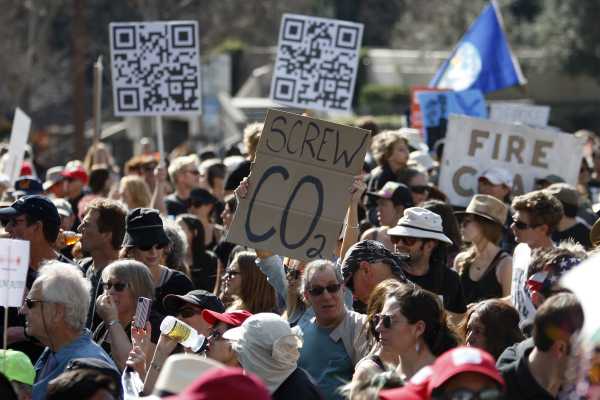
California’s aggressive carbon targets mean that cap and trade has to step up
At the center of this drama is California’s cap-and-trade system, which puts a declining cap on total emissions and issues tradable allowances under the cap.
Cap and trade was originally conceived as a kind of backstop for the state — a system that would mop up the emissions left behind after other regulations (fuel economy standards, building codes, renewable energy mandates) had done their work.
This has always been the advantage of a cap-and-trade system over a carbon tax: The cap is a guarantee of a specific level of emission reductions. It’s difficult to guess how much emissions might decline in response to a given level of carbon tax, whereas, at least in theory, cap-and-trade systems vouchsafe specific emission reductions. If emissions approach the cap, prices for carbon allowances simply rise and rise, as high as necessary to prevent the cap from being exceeded.
That’s the theory. The reality in California has been somewhat different. And the reality will matter much more in coming years.
To get a sense of the importance of cap and trade in California’s overall system, let’s take a quick run through some historical context.
In the beginning, there was AB 32, the California Global Warming Solutions Act of 2006. That law established the state’s initial target — a return to 1990 emission levels by 2020 — and gave wide latitude over program design to the California Air Resources Board (CARB). CARB designed the system of emission reductions, including the cap-and-trade system.
In 2016 came SB 32, which codified a 2030 target of 40 percent below 1990 levels. and in 2017 came AB 398, which officially extended the cap-and-trade system through 2030.
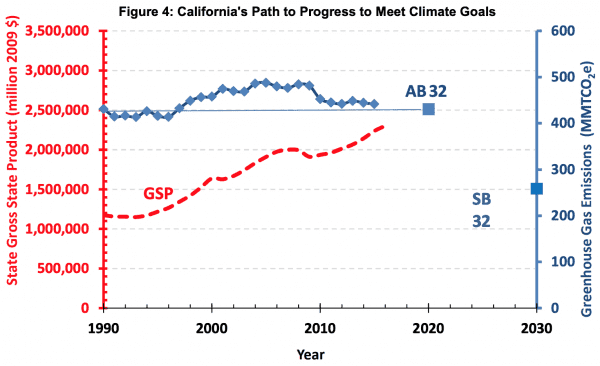
In the first phase of CARB’s policy plans (ending in 2020), cap and trade wasn’t called upon to do all that much. It was designed to account for about 15 percent of the state’s emission reductions, and it will likely end up accounting for less (experts differ on the exact amount).
To date, most of the state’s progress on emissions has come as a result of a broad suite of sector-specific regulations, everything from building codes to a low carbon fuel standard (LCFS), almost all of which turned out to be cheaper and more powerful than expected.
On top of that, the economy was substantially slowed by the 2008 recession, so economic activity (and carbon emissions) never climbed as high as expected.
The price of carbon allowances has been low for almost the entire life of the program, but it didn’t matter much, because cap and trade didn’t have much to do.
But the emission reductions required to hit the 2030 target dwarf those that have occurred so far. (And the state’s aspirational target, 80 percent reductions by 2050, is more ambitious still.) California needs big, rapid, sustained emission reductions across the entire economy, not just in a few headline sectors.
That means it’s going to need more out of its cap-and-trade system.
Sure enough, in its most recent “scoping plan” for achieving the 2030 target, CARB says that the cap-and-trade system is expected account for almost half of total emission reductions through 2030.
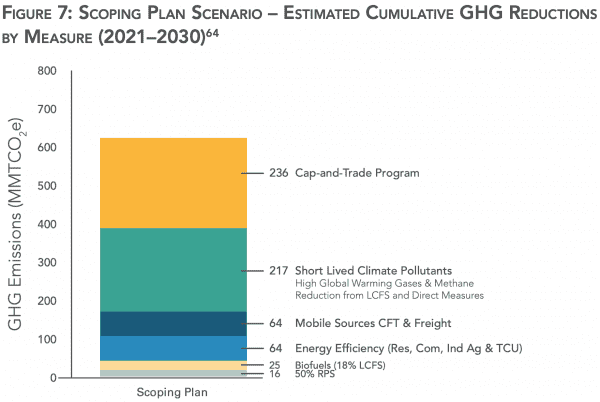
That’s a big boost from 15 percent. If the state is going to rely on cap and trade for that much of its decarbonization, it very much matters how the system is designed. And when it comes to design, the oil industry has wielded enormous influence.
California’s oil industry indelibly shaped its climate plans
California is popularly viewed as a bastion of liberalism, but if you look underneath the hood, especially on carbon policy, you find a more complicated story. There are three key bits of background to help understand why and how the oil industry plays such a big role in climate legislation.
First, the oil industry is huge in California. It has been for over a century. There are thousands upon thousands of wells dotting the lower Central Valley and the LA basin. The industry has been slowly declining in recent decades — California recently slipped from third to sixth in the ranks of oil-producing states — but it still has outsized influence in the state capitol. Though the Republican Party has been reduced to rubble in California, especially after the recent midterms, many “moderate” Dems from the Central Valley might as well be owned and operated by oil companies.
Second, in order to pass AB 398 and extend the cap-and-trade program through 2030, Brown was required to muster a two-thirds supermajority in the legislature. Proposition 26, a 2010 ballot initiative, requires a supermajority to raise fees (supplementing 1978’s Proposition 13, which requires a supermajority to raise taxes). There was some question about whether AB 398 could escape the requirements of Prop 26, but Brown didn’t want to take any chances.
Building a majority that big required winning over Dems who represent the oil industry. In practice, the supermajority requirement gave the oil industry veto power over the bill.
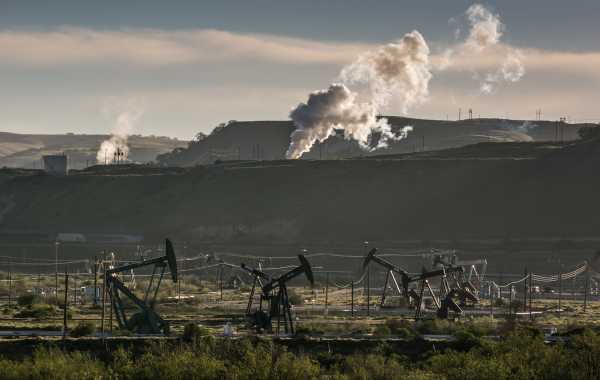
Third, cap and trade is Brown’s legacy, and the legacy of Mary Nichols, the longtime chair of CARB. Both have been working toward this for years and see the extension of cap and trade (and the broader decarbonization plan) as the culmination of a life’s work. They really, really wanted AB 398 and were ultimately willing to pay the pound of flesh the industry demanded.
As Kate Aronoff reported for In These Times last year, draft legislation for 398 was bouncing around Sacramento in late June, including to the governor’s office. “That proposal lifted several suggestions near-verbatim from an industry wishlist—drafted by a law firm contracted by the Western States Petroleum Association [WSPA]—of proposals for how to continue the cap-and-trade program,” Aronoff writes.
In a moment, we’ll look at a variety of ways that the oil industry shaped cap-and-trade design to its advantage. But most of the design problems trace back to one big problem: oversupply.
So to begin with, let’s take a look at oversupply. (Shout out to journalist Julie Cart, who did a great feature piece on this issue at CalMatters in May.)
Too many cheap allowances may hold carbon prices too low in California
Here’s oversupply in a nutshell: There are lots of cheap allowances sloshing around California’s carbon trading system, enough that industry could potentially cover most or all of its obligations out through 2030 using only stored-up allowances. If industries complied with cheap stockpiled allowances rather than real emission reductions, emissions would not decline 40 percent by 2030. The system would fall short.
Why are there so many cheap allowances in the system? Mainly because, as mentioned earlier, carbon pollution was lower than expected in the early years of the program. Cap and trade wasn’t called upon to do much.
The result was that more allowances were issued than were needed. The nonpartisan California Legislative Analysts Office (LAO), in a 2017 analysis for the state legislature, concluded that “there was an oversupply of allowances in the first three years of the program for which data is available (2013 through 2015) and there will very likely be an annual oversupply of allowances for the next few years of the program.”
Annual oversupply matters because California’s cap-and-trade system allows virtually unlimited “banking.” Regulated entities can buy more allowances than they need in a given year, hold (bank) them indefinitely, and use them against future emission obligations.
As the system was pumped full of allowances and prices were held low, lots of regulated entities bought more than they needed and banked them as a hedge against rising prices in the future.
There are now millions of banked allowances in the system and the number is only rising. LAO estimates that “cumulative oversupply of allowances in California’s cap-and-trade program through 2020 could range from 100 million to 300 million allowances, with it most likely being roughly in the middle of that range.”
Banking was originally a feature of the cap-and-trade program, meant to smooth year-to-year fluctuations in prices and give investors confidence. But it has become a bug.
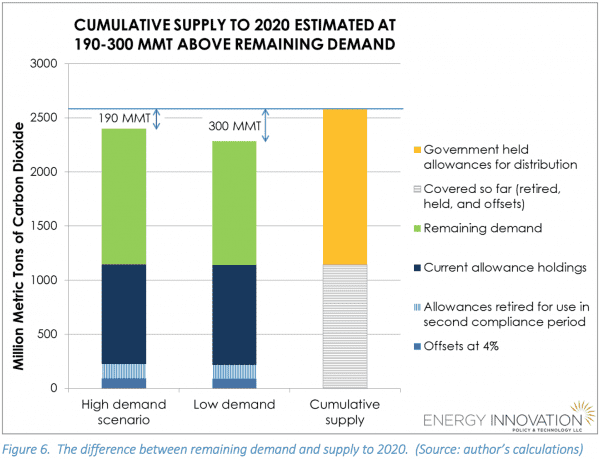
As the LAO notes, “one potential downside associated with banking is that it increases the risk that an annual emissions target in later years is not met because entities can comply in the later years by using banked allowances, rather than reducing emissions.”
This is a key point: California’s 2030 target is an annual emissions target, not a cumulative emissions target. What matters legally is not how much carbon is reduced overall, but how carbon intensive the economy is in 2030. And banking threatens that target.
As LAO says, relative to a world without all these excess allowances, “the oversupply makes the post-2020 program less stringent, which potentially increases emissions and puts downward pressure on prices.”
That is precisely the danger facing California: that through 2030, regulated entities can comply mostly with banked allowances, without reducing annual emissions.
It stands to reason that, at some point, as caps grow more stringent, the system will soak up all those banked allowances and regulated entities will return to buying new ones, or working harder to cut their carbon emissions.
Experts I talked to raise two worries. The first is that there’s so much slack in the system that the 2030 annual-emissions target won’t be met. The second is that, when banked allowances do run out, prices will snap sharply upward, raising political havoc. That’s a shock to the system nobody wants. And no one knows exactly when it might happen.
CARB has dismissed worries about oversupply
Concerns about oversupply in the California system have been raised for years, dating back at least to May 2016, when allowance prices collapsed and 90 percent of allowances went unsold. Later that year, Danny Cullenward, policy director at the think tank Near Zero, and Andy Coghlan of UC Berkeley published a paper in The Electricity Journal warning of “structural oversupply.”
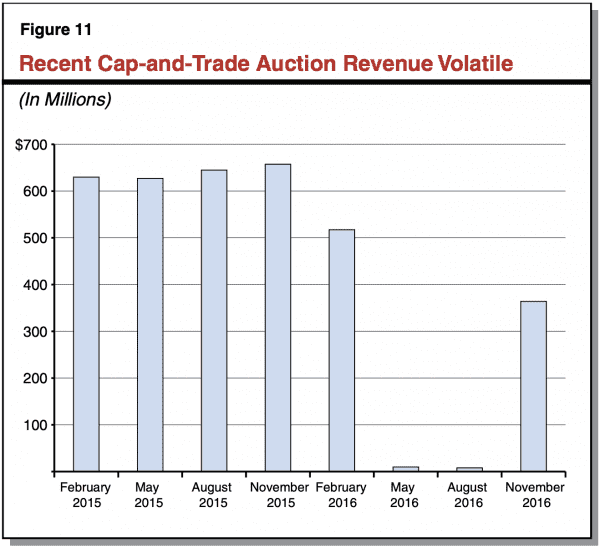
The Carbon Market Supply Association warned CARB in September 2016 that oversupply was “as high as 300 million tons.” Warnings were echoed by the LAO (in February 2017 and again in December 2017), Chris Busch at the energy policy firm Energy Innovation in December 2017, the Environmental Commissioner of Ontario (in a January 2018 report contemplating that province’s own carbon pricing system), Near Zero in March 2018 (and many times since; see here for a synthesis), and the Independent Emissions Market Advisory Committee in October 2018.
But CARB has remained unmoved.
The oil industry managed to block any legislative solution to oversupply in AB 398, but the bill did mandate that CARB at least take a look at the issue and analyze whether it threatened the 2030 target. Thus prodded, CARB held a workshop on oversupply in April 2018. At that meeting, it presented analysis purporting to show that cap and trade would in fact reduce sufficient emissions through 2030.
But it was a … strange analysis.
Recall, California is not targeting a cumulative reduction in greenhouse gases. It is targeting an annual-emissions rate, i.e., 40 percent below 1990 levels by 2030.
But CARB didn’t examine how banked allowances might affect annual emissions through 2030. Instead, it estimated how they might affect cumulative emissions.
In essence, CARB examined the balance between cumulative supply and demand. To calculate demand for allowances, it added up the total emissions projected over the period 2021 through 2030. To calculate the supply of allowances, it added up its proposed program caps and offset limits over the same period. Then it calculated the emissions reductions from cap and trade as the difference between supply and demand — because companies subject to the program have to reduce their emissions until supply and demand are equal, otherwise they will face steep penalties for falling out of program compliance.
Using this method, CARB determined that the program would produce enough cumulative reductions to match what it called for in the scoping plan. (CARB ran two scenarios, a control with no excess allowances banked into the post-2020 market and one that included 150 million excess allowances; both cleared the mark.)
But, again, California isn’t targeting cumulative reductions. Why not do what AB 398 and the legislature clearly intended, which is analyze whether the system will meet the statutory annual-emissions target for 2030?
When I asked CARB about it, spokesperson David Clegern noted that there are several other parts of the California system responsible for reducing emissions. “If it appears overall emissions are not declining as needed (and accounting for year-to-year variability due to climate, global fuel prices, or economic factors), CARB would determine which sectors are not responding as anticipated,” he said. “We would then review all programs that cover those sectors to determine if adjustments are necessary to hit California’s legislatively established GHG reduction targets.”
This amounts to saying that CARB can crank up other regulations if cap and trade falls short. But it has nothing to do with why CARB hasn’t analyzed the effect of oversupply on annual emissions. Several people have asked this question of CARB and no one, at least to my knowledge, got a straight answer.
Still, okay, say the analysis is taken at face value. Near Zero has argued that, not only is the analysis weird, it founders on a basic math error.
Rather than projecting future emissions from “covered emissions” — i.e., the demand for allowances from actual facilities covered by the cap-and-trade system — CARB’s PATHWAYS model projects future emissions from “covered sectors.” But there are a variety of “fugitive emission sources” within covered sectors that are exempt from the cap-and-trade system. “Covered emissions” are about 10 percent smaller than “covered sectors.”
By inflating the emissions under the program and then assuming those emissions will fall back down to program caps, Near Zero argues, CARB inflates the program’s calculated emission reductions. (Ironically, this error was specifically warned against by, uh, CARB, in 2010 — see below.)
Near Zero analysts ran CARB’s calculations again, with the error corrected. In the control scenario, the work shows that cap and trade will produce fewer emission reductions than required. In the oversupply scenario — which likely underestimates real-world oversupply — the cap-and-trade system will produce … no additional reductions through 2030. Zilch.
(Of course, as we’ll discuss later, there is a “price floor” beneath which allowance prices can’t fall, so the system will produce some reductions, but nothing like what is expected of it.)
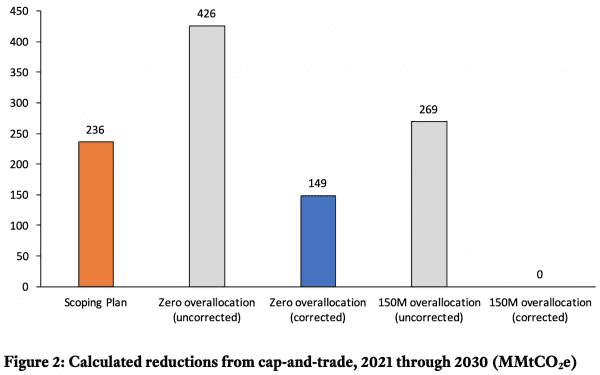
When the correct numbers are input, Near Zero argues, even CARB’s own calculations show that oversupply threatens the 2030 target.
I asked CARB’s Rajinder Sahota, who oversees the cap-and-trade program, about this discrepancy. She said that “we were aware that covered sectors in the PATHWAYS modeling do not match the covered sources under C&T” — i.e., covered sectors represent more emissions than covered emissions — but “caps are set and adjusted for these non-covered emissions, and if we make that adjustment again … it actually introduces an error into our analysis.”
This is the same answer CARB gave at the April workshop on the subject, and again in Appendix D of its pending cap-and-trade regulations. And at a hearing on November 15 — likely the last chance for substantive public input before the regulations for the next phase of cap and trade are put in place — CARB again denied that there is any problem.
Cullenward responds that the accuracy of the caps is not the question — his group’s analysis uses the same numbers CARB’s does — and that CARB “is admitting the error in the course of denying it.” Projected emissions, and thus projected emission reductions from cap and trade, are inflated. (The debate gets much more technical and arcane than this, but I will spare you.)
In 2010, CARB was conscious of the oversupply problem (and thus collapsed allowance prices) in the EU Emissions Trading System (ETS), which was due in part to regulators overestimating emissions at the outset. CARB was focused on using real, facility-level emissions data in its program.
“In 2007, [CARB] put in place a mandatory reporting program to provide accurate greenhouse gas emissions data for the sources that will be covered in the first compliance period of the cap-and-trade program,” it wrote in the staff report justifying its original program caps in 2010. “The data gathered through this program will help ensure that the over-allocation issue is not repeated in the California context.”
In 2018, for reasons it has never adequately explained, CARB returned to using an inflated number to project emissions.
The contested analysis from the April workshop remains the only analysis CARB has done of the risk of oversupply. It remains the only analysis CARB has done of whether the cap-and-trade system will be stringent enough to yield the emission reductions required of it.
That means, despite the clear intent of AB 398, there is still no analysis of whether cap and trade will yield the necessary reductions in annual emissions, which are the actual subject of the 2030 target.
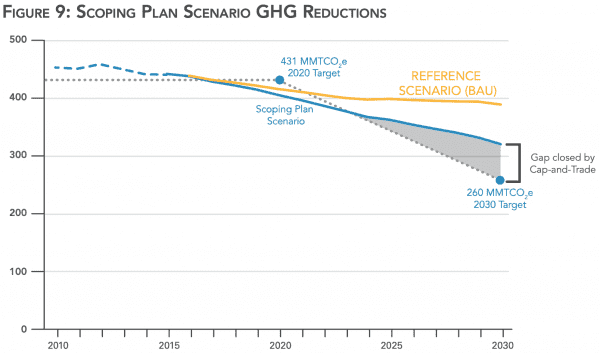
Oversupply is one of many design features keeping carbon prices low in California
The effect of oversupply, ceteris paribus, is to keep allowance prices low, which has always been the main policy priority of the oil industry.
And oversupply is part of a pattern, a whole series of design decisions meant to hold prices low.
Some of them are built into AB 398. For instance, the bill exempts oil and gas refineries and other polluting facilities covered by the cap-and-trade program from direct air-quality regulations determined at the district level. That infuriated environmental justice groups. The premise is that those facilities will be hit by rising carbon costs anyway … but if carbon costs aren’t allowed to rise, they won’t!
But most of the design details are in CARB’s hands, and CARB has mostly given the oil industry what it wanted, i.e., low prices.
Aside from failing to address oversupply, consider some other constraints on prices.
In its first phase, the cap-and-trade program had a “soft price ceiling” on allowances. If prices had hit that ceiling, a limited number of additional allowances would have been released. Of course, prices never got close to the ceiling, so it never mattered.
The second phase of the program will have a “hard price ceiling.” If allowance prices hit the ceiling, an unlimited number of new allowances can be released. That effectively means that there’s no longer a cap in the cap-and-trade system. Prices, not emissions, have a hard limit.
It will be a relatively low price ceiling, starting at just $50, but oversupply means that prices are unlikely to hit that ceiling either, so it probably still won’t matter much.
In practice, as CARB itself has admitted (more on that in a second), prices are much more likely to sit on the “price floor” — the minimum level to which allowance prices are allowed to decline — as they have for most of the life of the program.
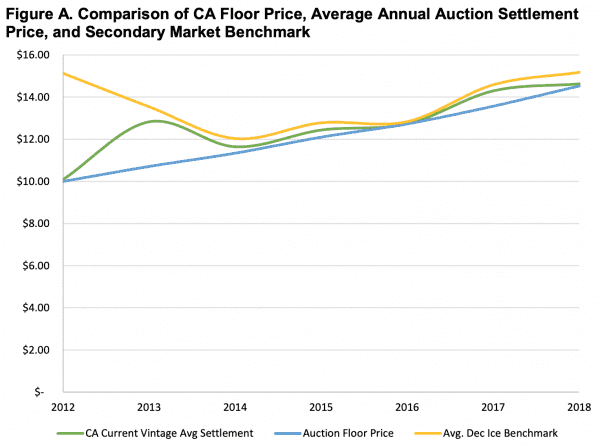
If that’s true, if the price sits on the floor through 2030, then the system will effectively act as a low and slowly rising carbon tax.
That makes the price floor is the most important number in the whole system. So what is that floor?
Well, back in 2010, CARB decided it should be $10, rising at 5 percent in real dollars every year. (It did not devote extensive analysis to that number, because it wasn’t intended to be the most important number in the whole system!) That decision, made under vastly different circumstances, with vastly different expectations placed on cap and trade, has not been revisited since.
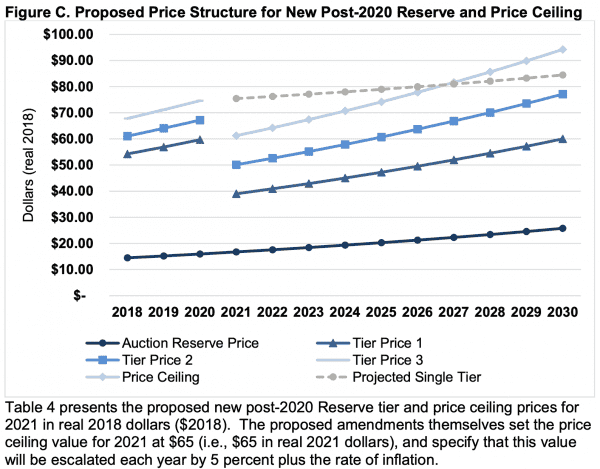
So the state has exempted oil facilities from direct regulation, implemented a low, hard price ceiling, kept the price floor at an absurdly low level, and failed to take any action on oversupply. (And that’s to say nothing of other unaddressed problems like “leakage” and “resource shuffling,” which I haven’t touched on here.)
Despite all this, CARB has found itself continually under fire from the oil industry.
CARB is in an abusive relationship with the oil industry
The November 15 hearing offered an illustration of all these dynamics.
Sahota testified, and when she did, she dismissed concerns about oversupply with the same language used in the April 2018 analysis.
But the more notable feature of the hearing was the endless procession of low-income and minority voters, having been terrified and then transported to the hearing by WSPA, the oil industry trade association. They begged CARB not to raise their gas prices and cut off their electricity and drive them out of their homes — as though the $50 price ceiling were a forecast rather than a theoretical upper bound (and as though the program offered nothing back to their communities).
It was a vivid display of the kind of manipulative, underhanded tactics the oil industry has been using in California for years, demanding concessions, getting them, and demanding more.
Around three hours and 45 minutes in, Nichols, exasperated, asks CARB staff to show their price forecast. But what they project on the screen is the graph above — the price floor and ceiling — not a forecast. Nichols seems to be implicitly conceding that CARB expects prices to sit on the price floor.
And lest there be any doubt, Sahota confirms:
So CARB’s position is that allowance prices will sit at or near the price floor through 2030, but that cap and trade will nonetheless reduce vastly more carbon emissions than it did in the system’s first phase, enough to hit the aggressive 2030 target.
That is … not plausible. (Severin Borenstein and colleagues at UC Berkeley did a preliminary forecast of allowance prices through 2030 and determined, as most researchers have, that macroeconomic factors like economic and population growth are the biggest sources of price uncertainty. There are circumstances in which low allowance prices could do the job, but it would basically require another recession.)
And it’s not like Sahota and Nichols aren’t aware of the tension between low prices and serious emission reductions. Here’s what Nichols said at a January legislative oversight hearing:
But CARB didn’t listen to the market experts. It recommended a system that is effectively an extension of the current one, with all its flaws and with additional features designed to keep prices low.
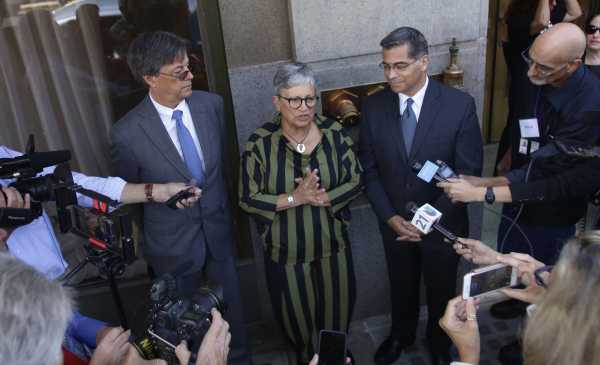
And still the oil industry keeps pushing. At one point in the hearing, Nichols, somewhat incredulously, asks Sahota how to explain the Western States Petroleum Association’s bad-faith display. After all, they had practically guaranteed low prices for the oil industry … and now this.
Sahota responded that in her judgment, with all this last-minute pressure, WSPA was taking “another bite at the apple.” When I asked her later what she meant by that, she said that WSPA wants to revisit the price ceiling. “From the very beginning of the design of the program, WSPA has wanted lower prices, even under the current soft ceiling,” she said, and WSPA viewed AB 398 as a “program reset,” a chance to redesign the system to its own specifications.
WSPA got much of what it wanted, but it will not be pacified. It won’t ever stop pushing for lower prices and lower ambition. That is literally its job and mission.
The future of cap and trade in California
As I said, CARB used to talk about cap and trade as a backstop, a guarantee of emission reductions. But in the past few months, staff language has shifted. Now the system is providing a “steadily rising carbon price signal.”
Given how flooded the system is with banked allowances (over 100 million and counting), that’s what CARB’s proposed cap-and-trade system will likely act as: a low, steadily rising carbon tax. The price of carbon will sit on a price floor decided semi-arbitrarily eight years ago — a price floor too low to spur the kinds of massive reductions needed.
There are plenty of things CARB could do to make the program more stringent. It could reform banking rules or raise the price floor. It could do what the EU ETS and the Regional Greenhouse Gas Initiative (RGGI) in the US northeast have done: create a rule-based ratchet that automatically reduces caps when banked allowances rise above some pre-determined level. If CARB implemented that system today, it would immediately push prices upward, as investors anticipate cap adjustments.
Or, if it is determined to keep prices low at all costs, CARB could simply concede that cap and trade will do less than expected and crank up other regulations to compensate.
But going into the second phase of the program with high expectations of cap and trade on one side, and an excess supply of allowances on the other, is not ideal. It’s a time bomb buried in the system.
The cynical take on all this is that in California, the oil industry simply has too much sway to allow a cap-and-trade system with real teeth. There is muttering in Sacramento that the whole system has become nothing more than an administratively burdensome carbon tax. And if that’s what it is, why not just dispense with the giant apparatus and implement a tax? If cap and trade isn’t providing a hard cap, a guarantee, its advantages over a tax are mooted.
Cap and trade was never going to go as long as Brown was governor and it won’t go as long as Nichols is at CARB (her term ends in 2020). But if, in the early 2020s, the price is still sitting at the floor, who knows what future legislators might do.
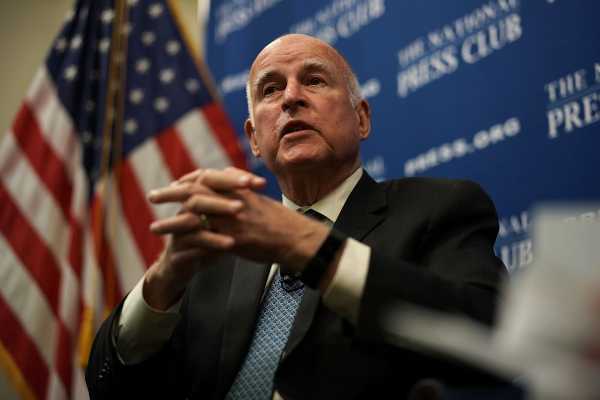
Sahota did express openness to revisiting the oversupply issue. “With so many different estimates of the 2013-2020 quantity of unused allowances, I believe it’s prudent to gather the data on the actual emissions through 2020,” she told me. “When that data is available in 2021 through the reporting program, staff would re-evaluate if any changes to allowance supply are needed.”
That will be another bite at the apple for those who want a cap-and-trade system stringent enough to meet the expectations put on it through 2030 — or at least an honest admission that cap and trade can’t do the job.
If CARB reacts the same way in 2020 that it has so far, dismissing oversupply concerns, the system will probably underperform. But even if that’s clear by, say, 2024, it will leave precious little time to make adjustments to meet the 2030 target. Alternatively, sometime in the 2020s the system could absorb the banked allowances and prices could spike. Either way, California carbon policy could blow up on incoming Gov. Gavin Newsom’s watch.
California’s climate narrative is one of courage and global leadership. But a little closer reveals a less rosy picture. Oil is still, in many respects, the gatekeeper of climate policy.
And now the state is in real danger of heading into 2020 with a cap-and-trade system expected to produce almost half the state’s ambitious carbon reductions — but flooded with cheap allowances and limping along at the price floor.
Implementation matters. The gap between California’s stated ambition and its program design, between image and reality, cannot be maintained forever. One or the other must give way.
Sourse: vox.com





